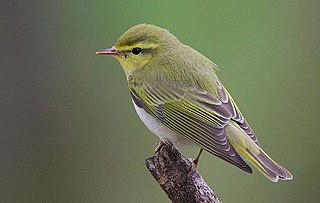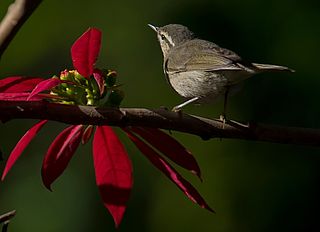
Leaf warblers are small insectivorous passerine birds belonging to the genus Phylloscopus. The genus was introduced by the German zoologist Friedrich Boie in 1826. The name Phylloscopus is from Ancient Greek phullon, "leaf", and skopos, "seeker".

The wood warbler is a common and widespread leaf warbler which breeds throughout northern and temperate Europe, and just into the extreme west of Asian Russia in the southern Ural Mountains.

The Arctic warbler is a widespread leaf warbler in birch or mixed birch forest near water throughout its breeding range in Fennoscandia and the northern Palearctic. It has established a foothold in North America, breeding in Alaska. This warbler is strongly migratory; the entire population winters in southeast Asia. It therefore has one of the longest migrations of any Old World insectivorous bird.

The yellow-browed warbler is a leaf warbler which breeds in the east Palearctic. This warbler is strongly migratory and winters mainly in tropical South Asia and South-east Asia, but also in small numbers in western Europe. Like the rest of Phylloscopidae, it was formerly included in the Old World warbler assemblage.

Hume's leaf warbler or Hume's warbler is a small leaf warbler which breeds in the mountains of inner Asia. This warbler is migratory and winters mainly in India.

The Western Bonelli's warbler is a warbler in the leaf warbler genus Phylloscopus. It was formerly regarded as the western subspecies of a wider "Bonelli's warbler" species, but as a result of modern taxonomic developments, this species is now usually considered to be two species:
The Kolombangara leaf warbler or sombre leaf warbler is a species of Old World warbler in the family Phylloscopidae. It is found only in Solomon Islands. Its natural habitat is subtropical or tropical moist montane forests. It is threatened by habitat loss.
Hartert's leaf warbler is a leaf warbler found only in China. Its natural habitats are temperate forests and subtropical or tropical moist lowland forests. It was previously considered a subspecies of Blyth's leaf warbler.

Kloss's leaf warbler is a leaf warbler found in Cambodia, China, Laos, Thailand, and Vietnam. Its natural habitats are temperate forests, subtropical or tropical moist lowland forests, and subtropical or tropical moist montane forests.

The Timor leaf warbler is a species of Old World warbler in the family Phylloscopidae. It is found on Timor island. Its closest relative is the Rote leaf warbler.

The Lompobattang leaf warbler is a species of Old World warbler in the family Phylloscopidae. It is found only in Sulawesi Island, Indonesia. The Sulawesi leaf warbler was formerly considered conspecific with the Lompobattang leaf warbler and both were grouped under the name P. sarasinorum, but more recent analyses indicate that it is a distinct species.

The mountain leaf warbler is a songbird species from the leaf warbler family (Phylloscopidae). It was formerly included in the "Old World warbler" assemblage.

The Tytler's leaf warbler is a songbird species. Like all leaf warblers, it was formerly placed in the "Old World warbler" assemblage, but now belongs to the new leaf-warbler family Phylloscopidae.

The green-crowned warbler is a species of leaf warbler. It was formerly included in the "Old World warbler" assemblage.

The chestnut-crowned warbler is a species of leaf warbler. It was formerly included in the "Old World warbler" assemblage.

The Sunda warbler is a species of Old World warbler in the family Phylloscopidae. It is found only in Indonesia.

The yellow-breasted warbler is a species of Old World warbler in the family Phylloscopidae. It is found in Indonesia, Malaysia, and Palawan Island in the Philippines. The species is most common on the islands of Sumatra and Borneo in Indonesia. Its natural habitats are subtropical or tropical moist lowland forest and subtropical or tropical moist montane forest.

Whistler's warbler is a species of leaf warbler. It was formerly included in the "Old World warbler" assemblage.

The limestone leaf warbler is a species of warbler in the family Phylloscopidae. When this species was first seen, beginning in 1994, it was mistaken for the similar sulphur-breasted warbler. It is smaller than the sulphur-breasted warbler, and has more rounded wings. The plumage is almost identical, with comparisons showing only a slightly colder yellow below and a greyer tinge above. Although smaller, the bill is proportionally larger than that of the sulphur-breasted warbler. Accurate measurements are not available; the holotype has a wing length of 5.2 centimetres (2.0 in); the paratype a tail length of 3.7 centimetres (1.5 in) and a bill length of 1.39 centimetres (0.55 in). The species is known to occur in northern Vietnam and Laos, and potentially also occurs in southern China as well. The species name, calciatilis, means "dwelling on limestone", which along with its common name is a reference to its natural habitat, which is broadleaved evergreen and semi-evergreen forest growing around limestone karst mountains. The bare-faced bulbul, described in 2009, was found in the karst of the same region.
The Rote boobook is a species of owl in the family Strigidae. It is endemic to Rote Island in the Lesser Sunda Islands of Indonesia.


















